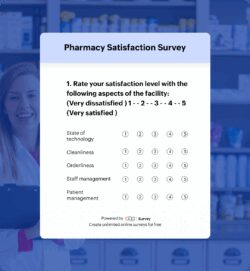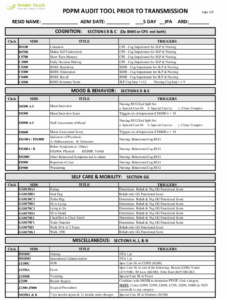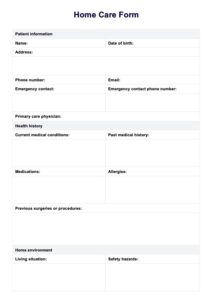In today’s dynamic healthcare landscape, truly understanding your patients’ experiences isn’t just a good idea; it’s absolutely crucial for providing top-notch care and fostering a thriving practice. Patient satisfaction directly impacts everything from their loyalty to your facility’s reputation and even its financial health. After all, happy patients are more likely to return, recommend you to others, and engage more actively in their own care journey.
But how do you really get inside their heads and understand what’s working well and what could use some improvement? The most effective way is by directly asking them. That’s where a well-crafted healthcare patient satisfaction survey template comes into play. It provides a structured, efficient way to gather invaluable feedback, helping you pinpoint areas of strength and identify opportunities for growth, ensuring you’re always evolving to meet and exceed patient expectations.
Why Patient Feedback is Absolutely Essential for Your Healthcare Practice
Think about it: every patient who walks through your doors has a unique experience, from the moment they try to book an appointment to their follow-up care. While you strive for excellence in every interaction, it’s impossible to know what every single patient is thinking or feeling unless you open a clear channel for their voice. Collecting patient feedback isn’t just about checking a box; it’s about continuously improving the quality of care you deliver and enhancing the overall patient journey.
This feedback acts as a powerful compass, guiding your practice toward better service delivery. For instance, if multiple patients consistently mention long wait times, you know exactly where to focus your efforts to streamline operations. If they praise the empathy of your nursing staff, you understand a key strength to highlight and reinforce. It helps you make data-driven decisions about staff training, facility improvements, administrative processes, and even the types of services you offer.
Beyond operational improvements, robust patient satisfaction directly impacts your practice’s long-term viability. Satisfied patients are your best advocates; they’re more likely to refer new patients, contributing to organic growth. Conversely, negative experiences, if left unaddressed, can lead to patient churn and damage your reputation, especially in an age where online reviews hold significant sway. By actively seeking and responding to feedback, you demonstrate a commitment to patient-centric care, building trust and loyalty within your community.
Ultimately, a systematic approach to gathering this information, like utilizing a comprehensive healthcare patient satisfaction survey template, empowers you to proactively address potential issues before they escalate, celebrate your successes, and continuously fine-tune every aspect of your patient care delivery. It transforms anecdotal observations into actionable insights, making your practice more responsive and resilient.
Key Areas to Cover in Your Survey
- Appointment Scheduling Experience: Was it easy to book an appointment? Were you offered convenient times?
- Wait Times: How long did you wait in the waiting room and then in the exam room? Was this reasonable?
- Staff Friendliness and Professionalism: How were you treated by the receptionists, nurses, and other support staff?
- Physician/Provider Communication: Did your doctor listen attentively? Did they explain things clearly and answer all your questions?
- Facility Cleanliness and Comfort: Was the environment clean, comfortable, and inviting?
- Billing and Insurance Process: Was the billing process clear and easy to understand? Were your insurance questions handled efficiently?
- Overall Experience and Likelihood to Recommend: How would you rate your entire visit? Would you recommend this practice to friends and family?
Designing Your Effective Healthcare Patient Satisfaction Survey Template
Crafting a truly effective survey isn’t just about listing questions; it’s about asking the *right* questions in the *right* way to elicit honest, actionable responses. Begin by defining your primary goals. Are you trying to improve appointment efficiency, boost staff morale through recognition, or identify gaps in patient education? Having clear objectives will help you tailor your questions and keep the survey focused.
Consider the types of questions you’ll use. A mix often works best. Likert scales (e.g., “Strongly Disagree” to “Strongly Agree”) are great for quantifiable data and trend analysis. Yes/No questions provide quick insights into specific processes. Open-ended questions are invaluable for capturing qualitative feedback, allowing patients to elaborate on their experiences in their own words, offering nuances that structured questions might miss. Balance these to ensure you get both measurable data and rich, descriptive insights.
One of the biggest challenges in survey design is ensuring a high completion rate. People are busy, and a long, cumbersome survey can be easily abandoned. Keep your healthcare patient satisfaction survey template concise and to the point. Use clear, simple language that’s easy for everyone to understand, avoiding medical jargon where possible. Design it for ease of completion, whether it’s an online form accessible on mobile devices or a well-structured paper questionnaire. Remember, the easier it is to complete, the more likely you are to get meaningful responses.
Once your template is ready, think about how you’ll distribute it. Offering multiple avenues – perhaps an email link after a visit, QR codes in waiting rooms, or even tablets for immediate feedback – can significantly boost participation. Encourage patients to share their thoughts by explaining how their feedback directly contributes to improving their care. And finally, the most crucial step: don’t just collect data. Analyze it, identify trends, share the findings with your team, and most importantly, implement changes based on what you learn. Showing patients that their feedback leads to tangible improvements reinforces their trust and willingness to participate in future surveys.
Understanding and responding to your patients’ experiences is a cornerstone of modern healthcare. By proactively seeking their input, you’re not just improving isolated processes; you’re cultivating a culture of continuous improvement that places the patient truly at its center. This ongoing dialogue ensures that your services remain relevant, high-quality, and deeply appreciated by those you serve.
Embracing this feedback loop will undoubtedly lead to stronger patient relationships, a more efficient and compassionate practice, and a reputation as a healthcare provider that genuinely cares. It’s an investment that pays dividends in both patient well-being and the sustained success of your organization.



